Themed collection Biomaterials Science 10th Anniversary Collection

Ten years of Biomaterials Science
An editorial from Jianjun Cheng and Maria Southall on the celebration of the journal's 10th anniversary.

Biomater. Sci., 2022,10, 6339-6340
https://doi.org/10.1039/D2BM90077G
Amphiphilic dendrimers against antibiotic resistance: light at the end of the tunnel?
With the alarming and prevailing antimicrobial resistance (AMR) comes an urgent need for novel biocompatible antimicrobial agents that are not only effective and robust but also do not induce resistance development

Biomater. Sci., 2023,11, 3379-3393
https://doi.org/10.1039/D2BM01878K
Development of substrates for the culture of human pluripotent stem cells
This review provides the latest progress of culture substrates for human pluripotent stem cells.
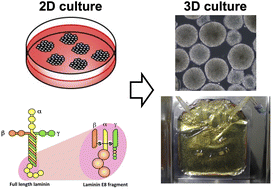
Biomater. Sci., 2023,11, 2974-2987
https://doi.org/10.1039/D2BM01473D
The foreign body response: emerging cell types and considerations for targeted therapeutics
The emerging role of T cells, stromal cells, and senescent cells and their interactions with other cell types in the FBR are discussed in this review. Additionally, factors that modulate the phenotype of these cells are briefly considered.
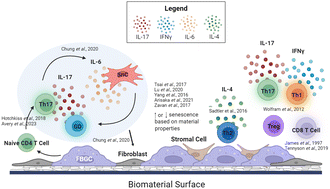
Biomater. Sci., 2023,11, 7730-7747
https://doi.org/10.1039/D3BM00629H
3D bioprinting complex models of cancer
Cancer is characterized by the uncontrolled division of cells, resulting in the formation of tumors. The personalized composition of biomaterials and 3D techniques can be used as a modelling tool to understand the complexity of various cancers.

Biomater. Sci., 2023,11, 3414-3430
https://doi.org/10.1039/D2BM02060B
Engineering optical tools for remotely controlled brain stimulation and regeneration
This review covers the latest progress in the application of light-responsive nanomaterials for on-demand drug delivery to the brain and for neuromodulation, with the aim of achieving brain stimulation and regeneration.

Biomater. Sci., 2023,11, 3034-3050
https://doi.org/10.1039/D2BM02059A
Biomedically-relevant metal organic framework-hydrogel composites
MOF-hydrogel composites are an emerging class of composite materials with many potential biomedical applications. In this review article, we discuss the state-of-the-art and prospects for future development.

Biomater. Sci., 2023,11, 2661-2677
https://doi.org/10.1039/D2BM01906J
Multivalent sialic acid materials for biomedical applications
In this review, we will briefly introduce the biomedical function of sialic acids in organisms and the utilization of multivalent sialic acid materials for targeted drug delivery as well as therapeutic applications including anti-inflammation and anti-viruses.

Biomater. Sci., 2023,11, 2620-2638
https://doi.org/10.1039/D2BM01595A
Recent strategies to develop pH-sensitive injectable hydrogels
Amphoteric pH-responsive polymers fused with both acidic and basic polymers exhibited sharp pH-swelling behavior in both acidic and basic media.

Biomater. Sci., 2023,11, 1948-1961
https://doi.org/10.1039/D2BM01519F
Expanding opportunities to engineer mucosal vaccination with biomaterials
Here we discuss material strategies for mucus penetration to deliver mucosal vaccines, including polymeric coatings, microneedle arrays, self-propulsion, mucus disruption, receptor targeting, and pathogen inspired methods. Created with Biorender.com.
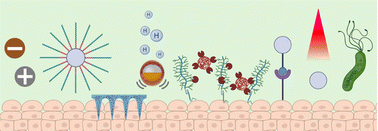
Biomater. Sci., 2023,11, 1625-1647
https://doi.org/10.1039/D2BM01694J
Recent nanotechnology-based strategies for interfering with the life cycle of bacterial biofilms
This review provides a comprehensive overview of the state-of-the-art progress in nanotechnology-based strategies for interfering with the biofilm life cycle according to the requirements of different stages.

Biomater. Sci., 2023,11, 1648-1664
https://doi.org/10.1039/D2BM01783K
Engineered bacteria for augmented in situ tumor vaccination
Engineered bacteria can be leveraged for in situ tumor vaccinations with their tumor-targeting ability and adjuvanticity. Engineering strategies like chemical modification, nanotechnology, and genetic engineering improve their safety and efficacy.
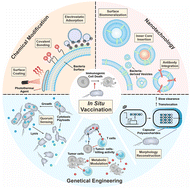
Biomater. Sci., 2023,11, 1137-1152
https://doi.org/10.1039/D2BM01593E
Recent advances in responsive antibacterial materials: design and application scenarios
Recent development in stimuli-responsive antibacterial materials is reviewed with particular focus on smart systems that can be tailored by intrinsic and external stimuli for selective and localized activation and treatment of specific diseases.

Biomater. Sci., 2023,11, 356-379
https://doi.org/10.1039/D2BM01573K
Pharmaceutical liposomal delivery—specific considerations of innovation and challenges
Liposomal technology can enhance drug solubility and stability, achieving codelivery for combination therapy, and modulate the in vivo fate (e.g., site-specific distribution and controlled release), thereby improving treatment outcomes.

Biomater. Sci., 2023,11, 62-75
https://doi.org/10.1039/D2BM01252A
Research progress of stimuli-responsive ZnO-based nanomaterials in biomedical applications
Herein, the emerging advances in some exogenous stimuli and endogenous stimuli responsive systems of ZnO-based nanomaterials in biomedical applications are highlighted, while their advantages and directions for improvement are also pointed out.
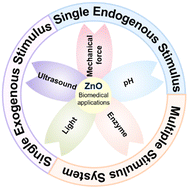
Biomater. Sci., 2023,11, 76-95
https://doi.org/10.1039/D2BM01460B
Facile fabrication of two-dimensional iodine nanosheets for antibacterial therapy
Herein, we report a facile approach for the preparation of two-dimensional iodine nanosheets (2D iodine NSs) with good stability and high biocompatibility via an aqueous solvent-assisted ultrasonic route.

Biomater. Sci., 2023,11, 1311-1317
https://doi.org/10.1039/D2BM01763F
Free drug and ROS-responsive nanoparticle delivery of synergistic doxorubicin and olaparib combinations to triple negative breast cancer models
Combinations of the topoisomerase II inhibitor doxorubicin and the poly (ADP-ribose) polymerase inhibitor olaparib offer potential drug–drug synergy for treatment of triple negative breast cancers (TNBC) both in free drug form and when delivered by oxidation-responsive nanoparticles.

Biomater. Sci., 2024,12, 1822-1840
https://doi.org/10.1039/D3BM01931D
Fluid flow-induced modulation of viability and osteodifferentiation of periodontal ligament stem cell spheroids-on-chip
Microfluidic spheroid-on-chip emulates physiologically relevant low fluid shear stress, resulting in improved PDLSC viability, enhanced osteodifferentiation, and uniform calcium deposition, offering new possibilities for periodontal research.

Biomater. Sci., 2023,11, 7432-7444
https://doi.org/10.1039/D3BM01011B
Cationic copolymer and crowding agent have a cooperative effect on a Na+-dependent DNAzyme
A cationic copolymer and a crowding agent enhance the cleavage activity of a Na+-dependent DNAzyme. The combination of the copolymer and crowding agent displays a cooperative effect, resulting in a 46-fold enhancement of DNAzyme activity.

Biomater. Sci., 2023,11, 7062-7066
https://doi.org/10.1039/D3BM01119D
In vivo targeting of a tumor-antigen encoded DNA vaccine to dendritic cells in combination with tumor-selective chemotherapy eradicates established mouse melanoma
Eradicating established mouse melanoma by tumor-selective chemotherapy in combination with in vivo dendritic cell targeted genetic immunization using a tumor antigen encoded DNA vaccine.
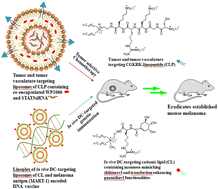
Biomater. Sci., 2023,11, 6135-6148
https://doi.org/10.1039/D3BM00702B
Combinatorial extracellular matrix cues with mechanical strain induce differential effects on myogenesis in vitro
Murine myoblasts cultured on combinatorial extracellular matrix (ECM) proteins are exposed to uniaxial strain. The combined effects of ECMs and strain on myogenesis are investigated by transcriptomic and protein analyses.
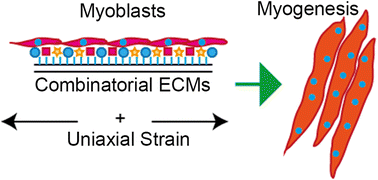
Biomater. Sci., 2023,11, 5893-5907
https://doi.org/10.1039/D3BM00448A
Injectable biomaterial induces regeneration of the intervertebral disc in a caprine loaded disc culture model
Here, the efficacy of an injectable hydrogel system (NPgel), either alone or together with progenitor cells, was investigated within a degenerate loaded disc model. NPgel inhibited cellular catabolism and promoted anabolism, supporting regeneration.
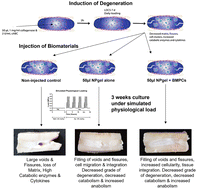
Biomater. Sci., 2023,11, 4630-4643
https://doi.org/10.1039/D3BM00150D
Toxicity and efficacy of green tea catechin derivative-based micellar nanocomplexes for anticancer protein delivery
Green tea-based micellar nanocomplexes (MNCs) for tumor-targeted delivery of anticancer proteins are not just drug carriers but therapeutic themselves. MNCs induce apoptosis in cancer cells with no or very low toxicity for HUVECs and kidney cells.

Biomater. Sci., 2023,11, 4675-4683
https://doi.org/10.1039/D2BM01969H
Facile synthesis of poly(disulfide)s through one-step oxidation polymerization for redox-responsive drug delivery
A facile one-step oxidation polymerization strategy was developed to construct biodegradable poly(disulfide)s (PBDBM) for redox-responsive drug delivery with reduced systemic toxicity.

Biomater. Sci., 2023,11, 4254-4264
https://doi.org/10.1039/D3BM00461A
In vivo evaluation of compliance mismatch on intimal hyperplasia formation in small diameter vascular grafts
Synthetic vascular grafts with varied compliance were fabricated and studied in vivo. Reducing compliance mismatch between graft and native artery lowered intimal hyperplasia formation and increased graft patency.

Biomater. Sci., 2023,11, 3297-3307
https://doi.org/10.1039/D3BM00167A
Intracellular delivery of bacterial effectors for cancer therapy using biodegradable lipid nanoparticles
We report herein the delivery of bacterial effector protein DUF5 using bioreducible lipid nanoparticles for mutant RAS degradation and downstream cell signalling reprogramming for cancer therapy.
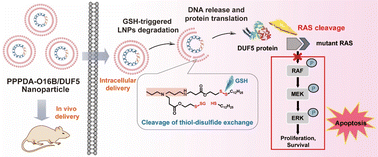
Biomater. Sci., 2023,11, 3172-3179
https://doi.org/10.1039/D3BM00008G
Immunogenicity assessment of swim bladder-derived biomaterials
The swim bladder-derived material did not elicit significant aberrant immune responses by in vitro and in vivo assays, giving strong confidence for its application in tissue engineering or medical devices.

Biomater. Sci., 2023,11, 2738-2749
https://doi.org/10.1039/D2BM01419J
Nitric oxide scavengers based on o-phenylenediamine for the treatment of rheumatoid arthritis
We discovered an o-PD-based NO scavenger that is highly reactive with NO as an agent for RA treatment. We believe that the N-Me has potential applications for developing anti-inflammatory disease treatments targeting NO.

Biomater. Sci., 2023,11, 2395-2404
https://doi.org/10.1039/D2BM01994A
A natural polyphenol-functionalized chitosan/gelatin sponge for accelerating hemostasis and infected wound healing
A multifunctional natural polyphenol-functionalized chitosan/gelatin sponge (PCGS) is reported for hemostatic and infected wound therapy.
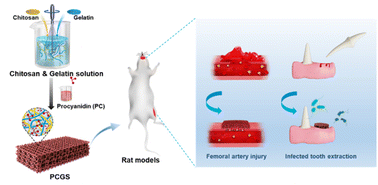
Biomater. Sci., 2023,11, 2405-2418
https://doi.org/10.1039/D2BM02049A
Development of lipidated polycarbonates with broad-spectrum antimicrobial activity
Lipidated polycarbonates display broad-spectrum antimicrobial activity.

Biomater. Sci., 2023,11, 1840-1852
https://doi.org/10.1039/D2BM01995G
Histidine-based coordinative polymers for efficient intracellular protein delivery via enhanced protein binding, cellular uptake, and endosomal escape
Histidine-based coordinative polymers overcome multiple barriers, and achieve efficient cytosolic protein delivery.

Biomater. Sci., 2023,11, 1765-1775
https://doi.org/10.1039/D2BM01541B
Development and optimization of an ocular hydrogel adhesive patch using definitive screening design (DSD)
Bioadhesive hydrogel patches based on chemically modified photocrosslinkable polymers with specific physicochemical properties for sealing and repair of ocular injuries.
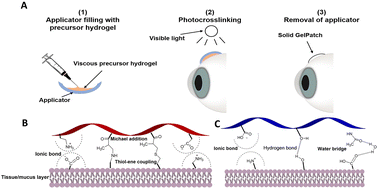
Biomater. Sci., 2023,11, 1318-1334
https://doi.org/10.1039/D2BM01013E
Thermoresponsive shear-thinning hydrogel (T-STH) hemostats for minimally invasive treatment of external hemorrhages
p(NIPAM) and LAPONITE®-based thermoresponsive shear-thinning hydrogel (T-STH) hemostats are designed to function as reversible hemostats for emergency situations. They exhibit temperature dependent coagulation and improved clotting times.
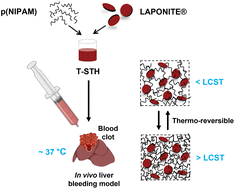
Biomater. Sci., 2023,11, 949-963
https://doi.org/10.1039/D2BM01559E
Endogenous stimulus-responsive nitric oxide releasing bioactive liposome for a multilayered drug-eluting balloon
Drug eluting balloon (DEB) system has been designed to enable synergistic therapeutic effects with nitric oxide while reducing the amount of cytostatic drug (EVL), along with the various advantages expected by using a multilayer coating strategy.
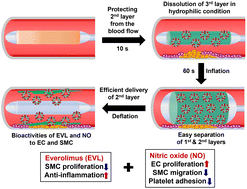
Biomater. Sci., 2023,11, 916-930
https://doi.org/10.1039/D2BM01673G
Baicalein-functionalized collagen scaffolds direct neuronal differentiation toward enhancing spinal cord injury repair
Baicalein was discovered to direct neuronal differentiation. Based on this, a baicalein functionalized collagen scaffold (BFCS) was developed for spinal cord injury (SCI) repair, which enhanced neurogenesis and motor functional recovery of SCI rats.

Biomater. Sci., 2023,11, 678-689
https://doi.org/10.1039/D2BM01467J
An antibacterial and proangiogenic double-layer drug-loaded microneedle patch for accelerating diabetic wound healing
A double-layer microneedle patch DMN@TCH/DFO was prepared and released TCH and DFO to accelerate wound healing through antibacterial and angiogenesis-promoting processes, and provides a new choice for diabetic wound repair.
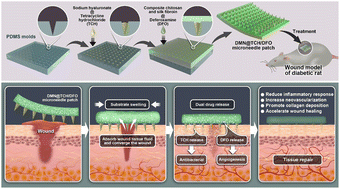
Biomater. Sci., 2023,11, 533-541
https://doi.org/10.1039/D2BM01588A
Antiviral supramolecular polymeric hydrogels by self-assembly of tenofovir-bearing peptide amphiphiles
Tenofovir-conjugated peptide amphiphiles can assemble and form hydrogels under physiological conditions for sustained therapeutic release. Varying the number of valines in the designs impacts their self-assembly, gelation, and release behavior.

Biomater. Sci., 2023,11, 489-498
https://doi.org/10.1039/D2BM01649D
Single-component lipid nanoparticles for engineering SOCS1 gene-silenced dendritic cells to boost tumor immunotherapy
Single-component lipid nanoparticles are designed and prepared for delivery of SOCS1 siRNA to primary DCs, which can be further pulsed with Ova-antigen to fabricate a SOCS1-downregulated DC vaccine with the potential to boost antitumor immunotherapy.

Biomater. Sci., 2023,11, 263-277
https://doi.org/10.1039/D2BM01549H
Dendritic lipopeptide liposomes decorated with dual-targeted proteins
A tumor-targeted dendritic lipopeptide liposome was developed to improve the anticancer effect of loaded drugs by enhancing tumor targeting, cancer cell endocytosis and tumor penetration.

Biomater. Sci., 2022,10, 7032-7041
https://doi.org/10.1039/D2BM00952H
Stepwise photothermal therapy and chemotherapy by composite scaffolds of gold nanoparticles, BP nanosheets and gelatin immobilized with doxorubicin-loaded thermosensitive liposomes
The incorporation of AuNRs and biodegradable BP nanosheets in scaffolds containing Dox-encapsulated thermosensitive liposomes enables synergistic PTT and chemotherapy or mild-hyperthermia-induced chemotherapy before and after BP degradation.
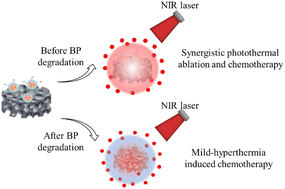
Biomater. Sci., 2022,10, 7042-7054
https://doi.org/10.1039/D2BM01155G
Sea urchin-like Bi2S3/curcumin heterojunction rapidly kills bacteria and promotes wound healing under near-infrared light
Bi2S3/Cur photocatalysis and photothermal synergistic bactericidal effect under 808 nm near infrared light.
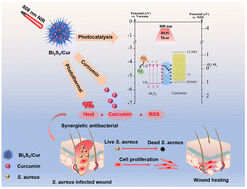
Biomater. Sci., 2022,10, 6377-6387
https://doi.org/10.1039/D2BM01474B
Aqueous synthesis and self-assembly of bioactive and thermo-responsive HA-b-ELP bioconjugates
A library of diblock HA-b-ELP bioconjugates was synthesized by a simple synthetic and purification procedure in water. Their self-assembly properties were deeply investigated to assess their structure–property relationships.
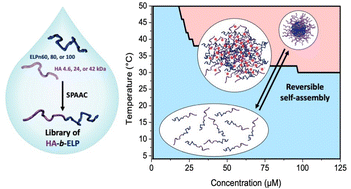
Biomater. Sci., 2022,10, 6365-6376
https://doi.org/10.1039/D2BM01149B
Targeted delivery of liver X receptor agonist to inhibit neointimal hyperplasia by differentially regulating cell behaviors
We developed a targeted nanomedicine encapsulating the liver X receptor agonist T0901317 for differentially regulating the behaviors of HUVECs and HASMCs.

Biomater. Sci., 2022,10, 6354-6364
https://doi.org/10.1039/D2BM01041K
Microneedle patch with “spongy coating” to co-load multiple drugs to treat multidrug-resistant melanoma
Microneedle Patch with porous spongy coating could achieve the synergistic administration of SAHA and CBP for treatment of multidrug-resistant melanoma.

Biomater. Sci., 2022,10, 6282-6290
https://doi.org/10.1039/D2BM01275H
Spherical α-helical polypeptide-mediated E2F1 silencing against myocardial ischemia-reperfusion injury (MIRI)
Spherical α-helical polypeptide (SPP) mediated effective E2F1 silencing in the myocardium for the treatment of ischemia reperfusion injury.

Biomater. Sci., 2022,10, 6258-6266
https://doi.org/10.1039/D2BM01075E
pH-Sensitive nanocarrier assisted delivery of adenosine to treat osteoporotic bone loss
pH-Sensitive nanocarriers deliver adenosine to the bone tissue and mitigate osteoporotic-mediated bone loss through the promotion of osteoblastogenesis and inhibition of osteoclastogenesis.
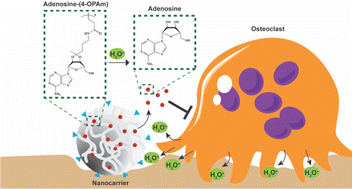
Biomater. Sci., 2022,10, 5340-5355
https://doi.org/10.1039/D2BM00843B
Polyaspartate-derived synthetic antimicrobial polymer enhances the activity of rifampicin against multidrug-resistant Pseudomonas aeruginosa infections
Infections caused by multidrug-resistant Pseudomonas aeruginosa (P. aeruginosa) pose major challenges for treatment due to the acquired, adaptive, and intrinsic resistance developed by the bacteria.
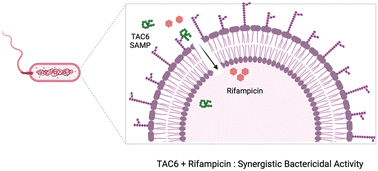
Biomater. Sci., 2022,10, 5158-5171
https://doi.org/10.1039/D2BM00524G
Spatial delivery of immune cues to lymph nodes to define therapeutic outcomes in cancer vaccination
Local signal integration in lymph nodes (LNs) controls the potency and selectivity of immune responses. Here, intra-LN depots were used to direct communication within treated LNs, causing programmable and divergent systemic immunotherapy outcomes.
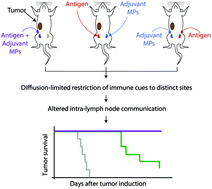
Biomater. Sci., 2022,10, 4612-4626
https://doi.org/10.1039/D2BM00403H
Biodegradable peptide polymers as alternatives to antibiotics used in aquaculture
Biodegradable peptide polymers display potent and broad-spectrum antibacterial activity in vitro, as well as strong therapeutic potential in vivo, as a promising alternative to antibiotics in aquaculture.
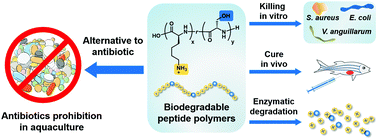
Biomater. Sci., 2022,10, 4193-4207
https://doi.org/10.1039/D2BM00672C
Nanodrug regulates lactic acid metabolism to reprogram the immunosuppressive tumor microenvironment for enhanced cancer immunotherapy
A novel strategy of tumor microenvironment reprogramming by Intra/extracellular lactic acid exhausting for antitumor immune therapy.

Biomater. Sci., 2022,10, 3892-3900
https://doi.org/10.1039/D2BM00650B
Mild phototherapy mediated by manganese dioxide-loaded mesoporous polydopamine enhances immunotherapy against colorectal cancer
The application of MnO2@MPDA-PEG NPs for reshaping the tumor microenvironment under mild PTT inhibits tumor growth.

Biomater. Sci., 2022,10, 3647-3656
https://doi.org/10.1039/D2BM00505K
pH-Responsive hyaluronic acid-cloaked polycation/gold nanohybrids for tumor-targeted synergistic photothermal/gene therapy
The current work provides a facile strategy to construct multifunctional gene delivery systems with long circulation and tumor-targeting characteristics for effective tumor treatment.

Biomater. Sci., 2022,10, 2618-2627
https://doi.org/10.1039/D2BM00296E
About this collection
September 2022 marks 10 years since the first articles were published in Biomaterials Science and as part of the celebrations for Biomaterials Science’s 10th Anniversary, we are delighted to introduce to you our 10th Anniversary Collection. Featuring high quality research and review articles from some of the top authors in biomaterials, we hope you enjoy reading this special collection.
We would like to thank all of our authors, reviewers, and readers for your incredible support since we launched and we look forward to seeing what developments the next decade will bring!